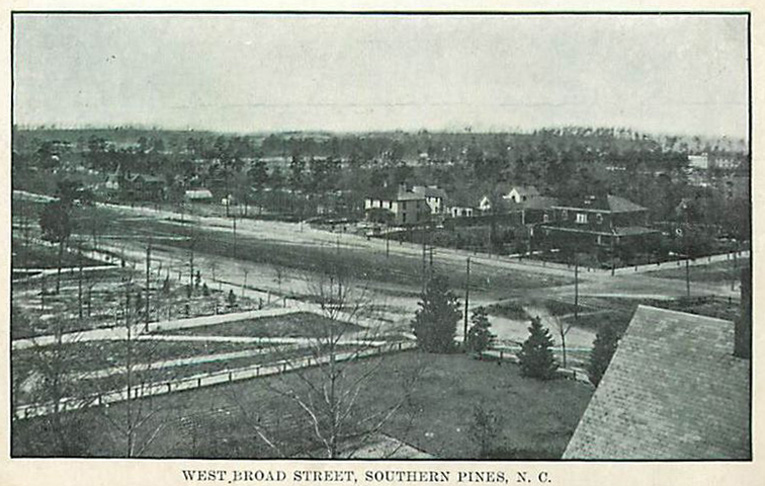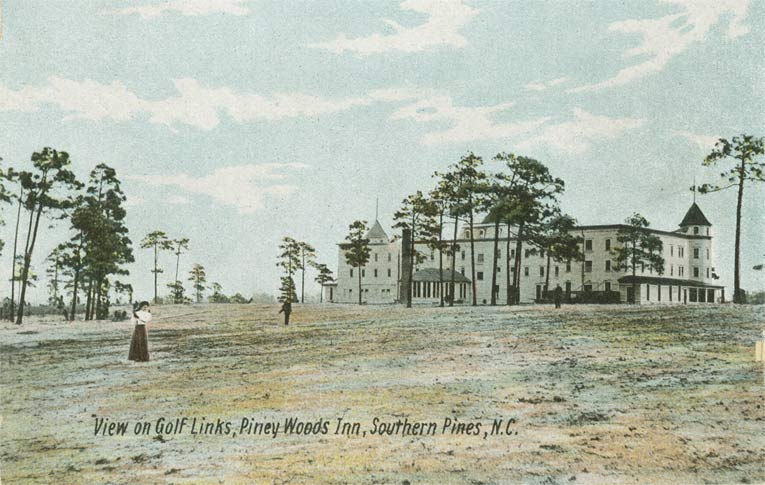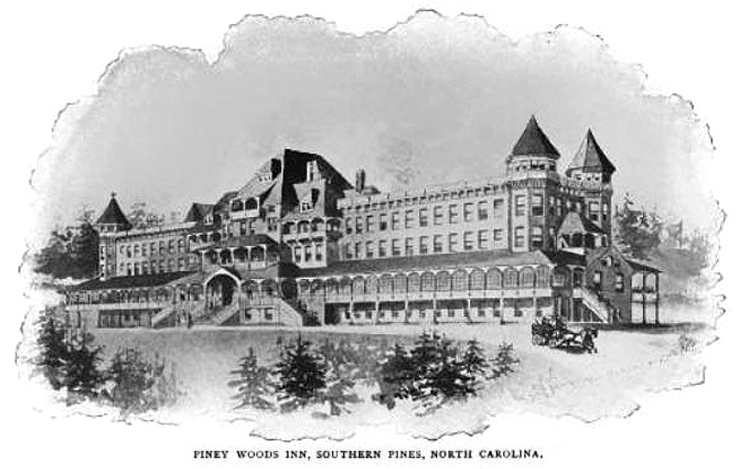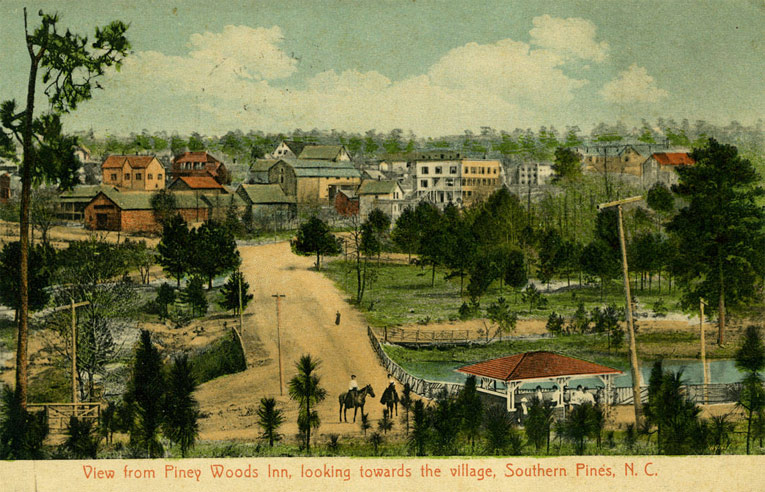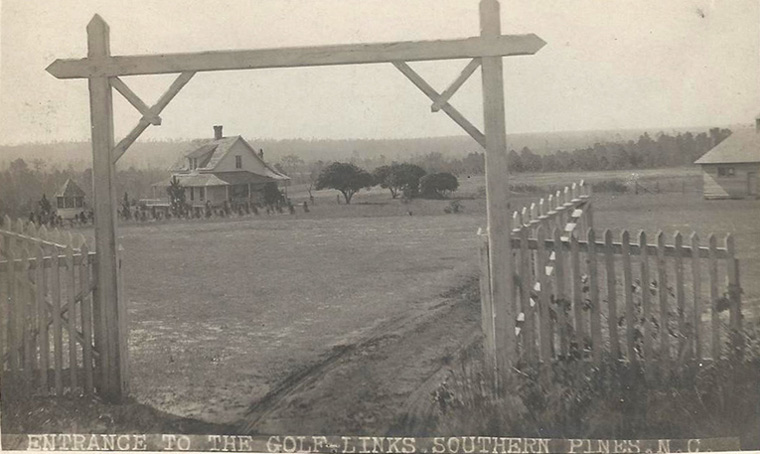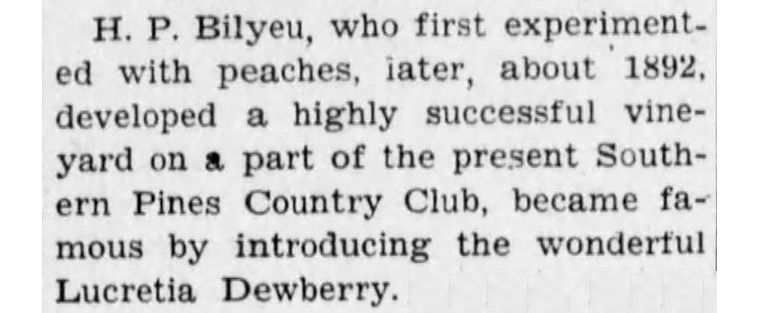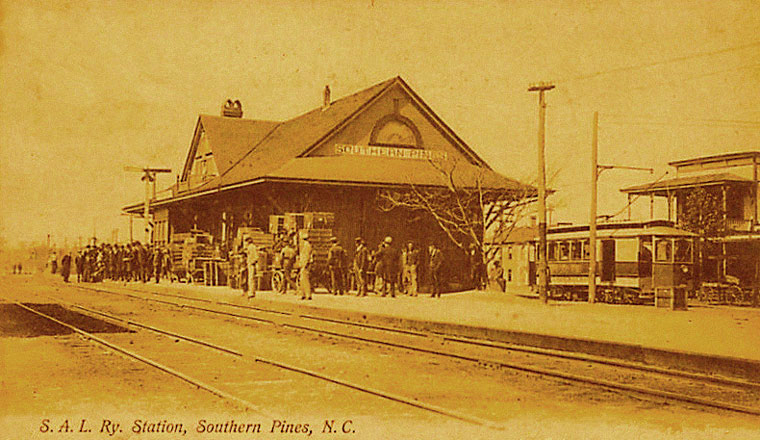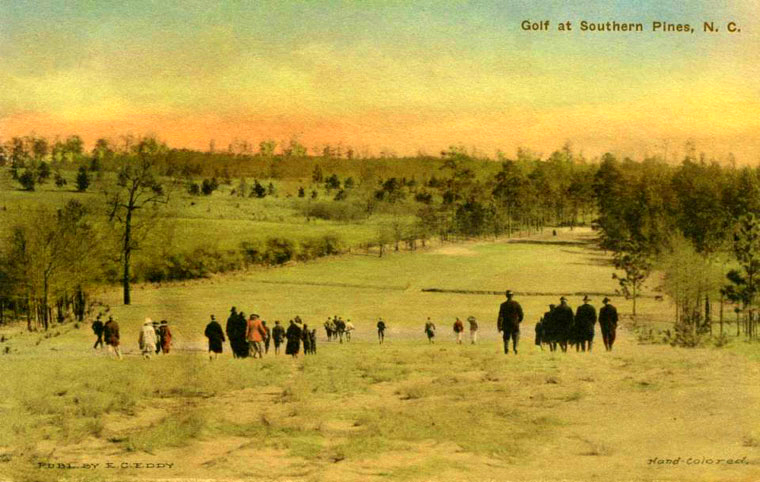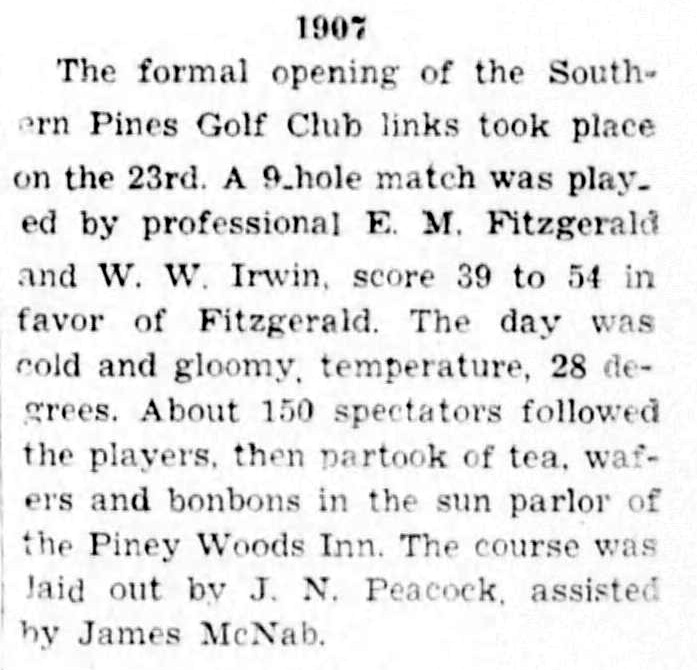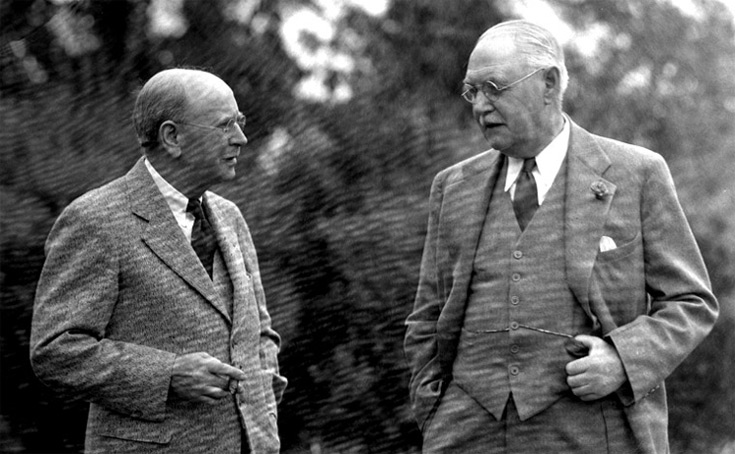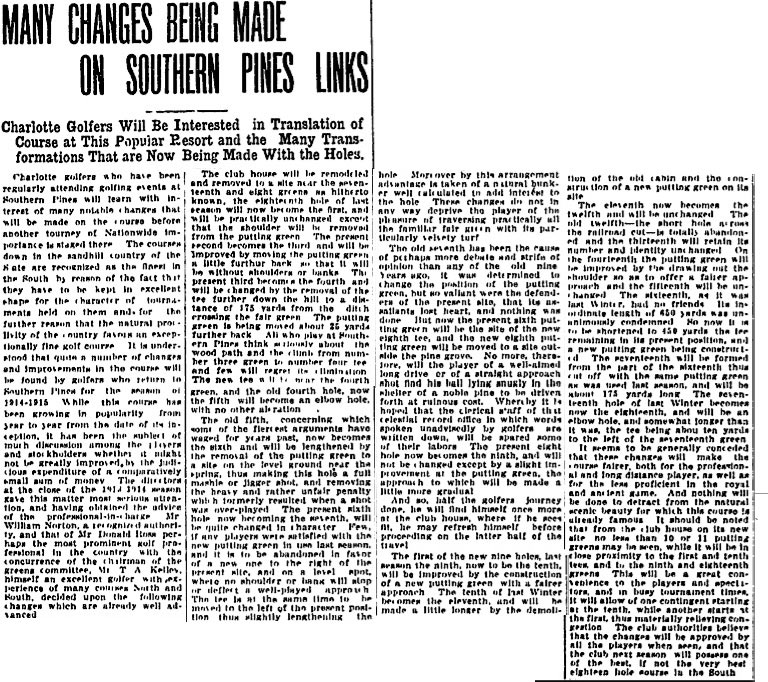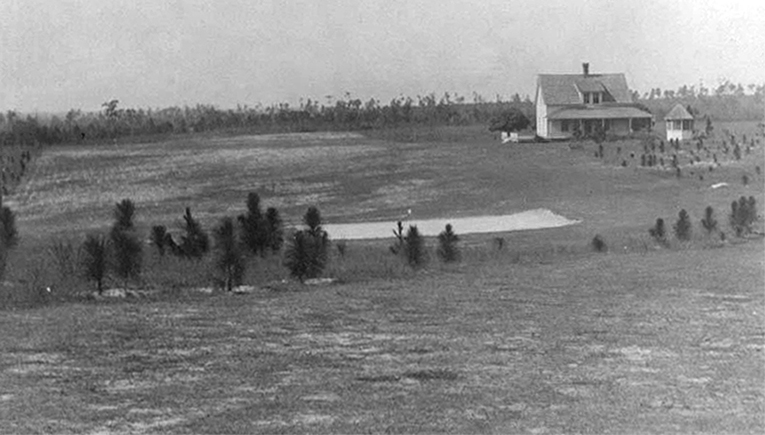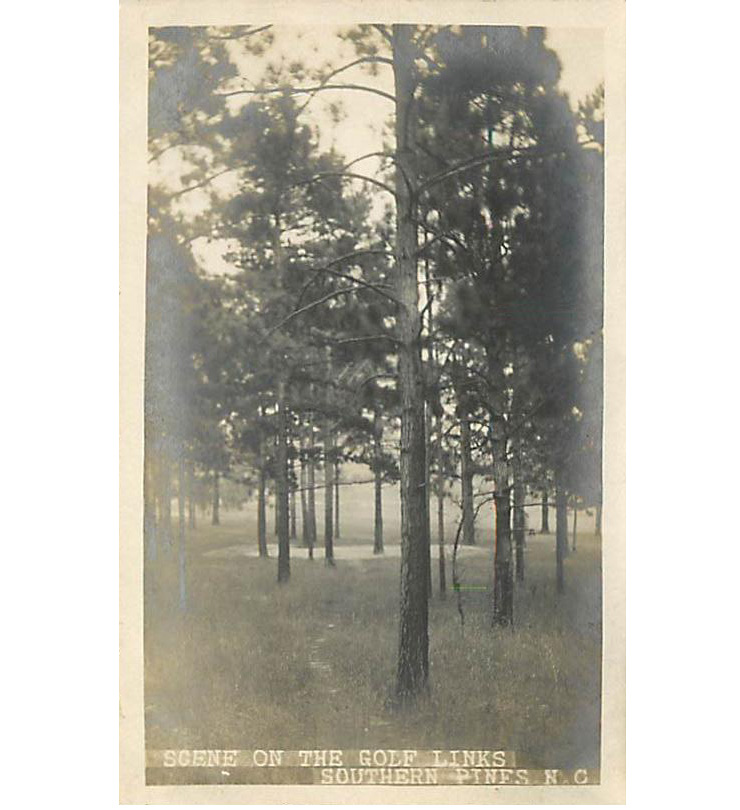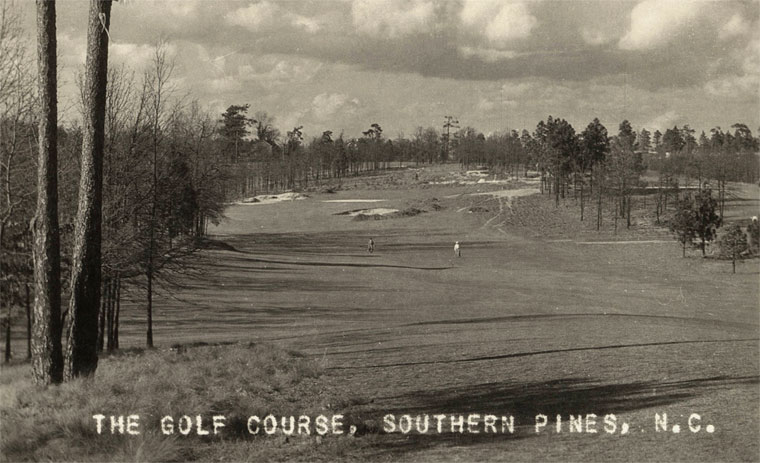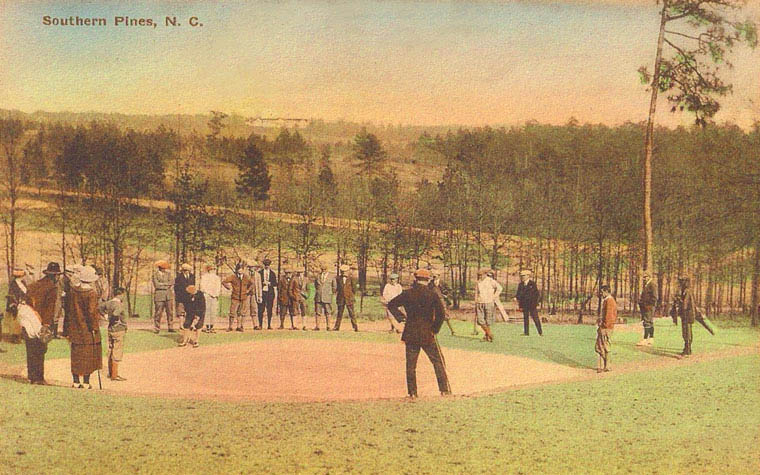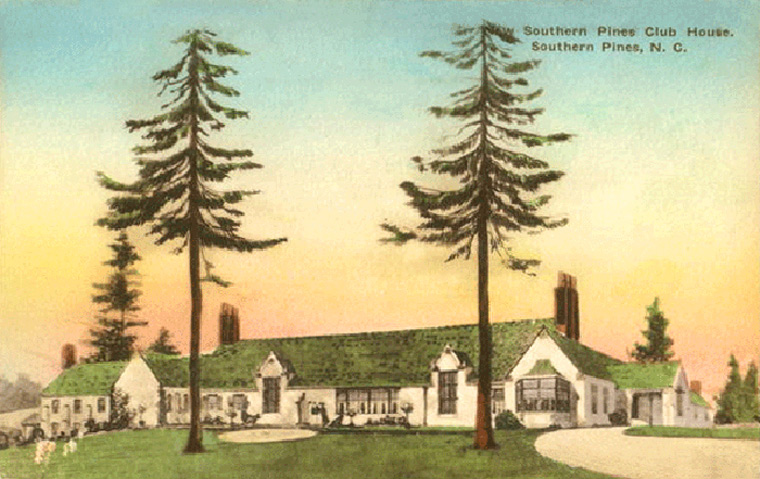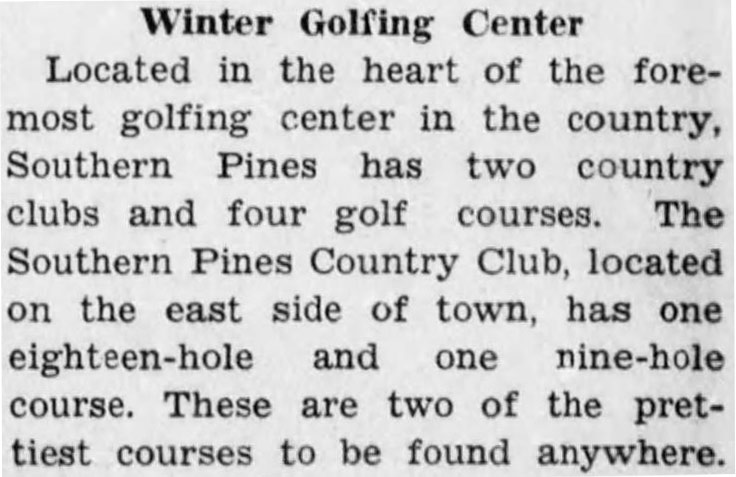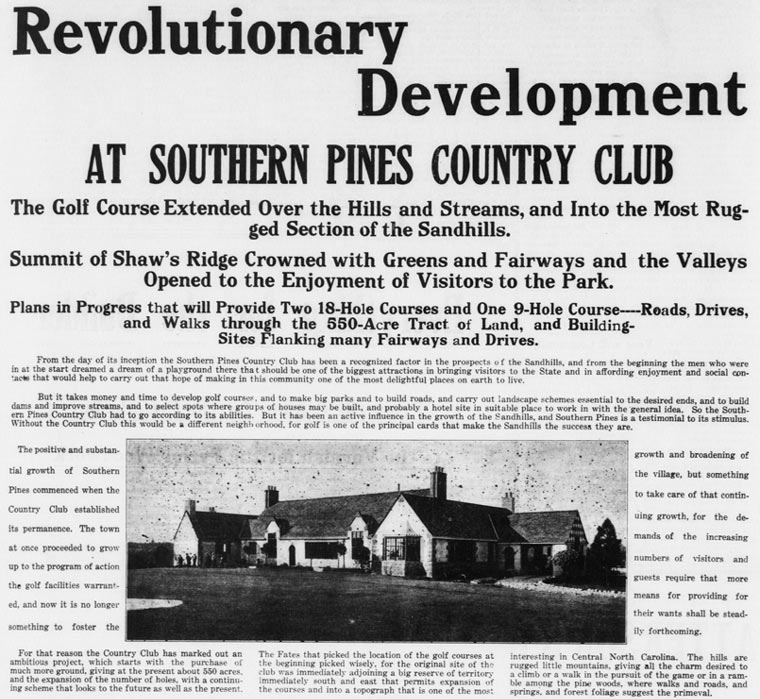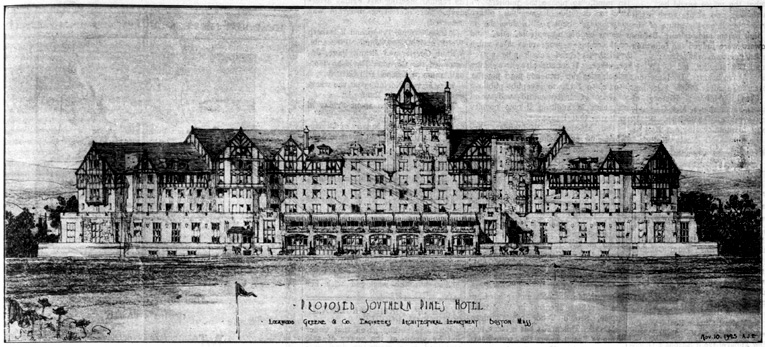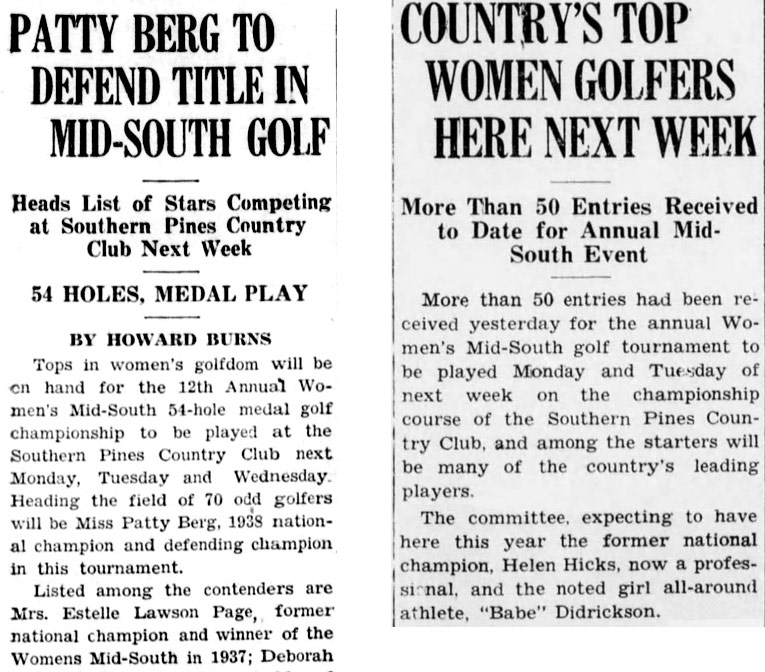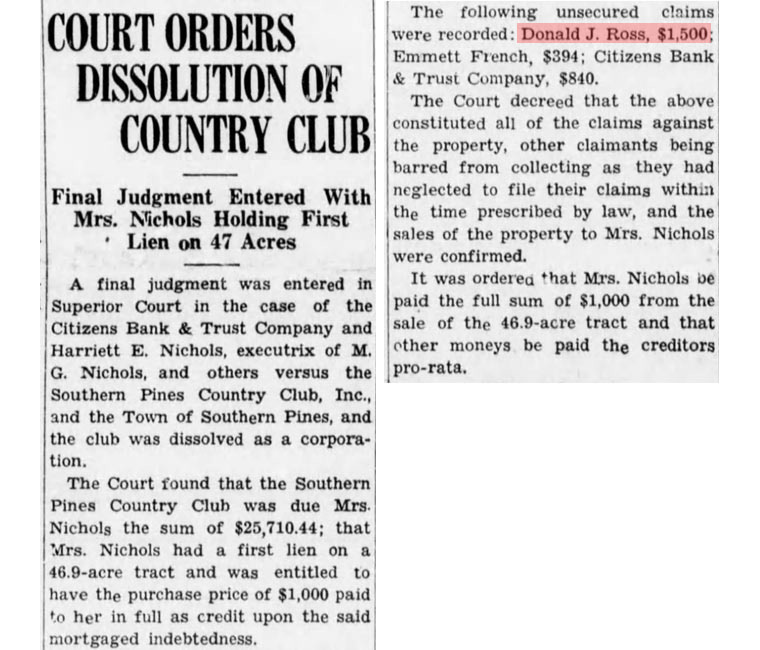A History of Southern Pines Golf Club
Chris Buie
September 2013
The club property has served the community as a park as well as a playground for followers of the old Scotch game, and as such has many fascinations. Glimpses through the close set trees to sunlit pools and shadow-dappled fairways, vistas through the tall pines to the far off hills crowned in blue haze and shadows; distant views over the expanse of greensward and tree-lined valleys to the bulk of Paint Hill and the blue ridge far beyond Aberdeen, and to the dark crest of Mount Hope and the clustered homes of Pinedene afford a restive diversion for all lovers of the out-of-doors. – Pilot Newspaper on SPGC – 1935
At the turn of the previous century Southern Pines had yet to become a winter haven for refugees from the frozen North. As is well known, that was not the case next door in Pinehurst. A winter haven is exactly what it was becoming by leaps and bounds. The visitors made the southward journey on the rails of the Seaboard Air Line Railway with one last stop before reaching their final destination in Pinehurst.
The people of Southern Pines would welcome the wealthy travelers for just a few minutes before they rolled out of town just about as quickly as they rolled in. This went on for a few years with the citizens and businessmen of Southern Pines becoming increasingly put out by their lack of benefit from the influx. At the time Southern Pines was more than a little down at the heel. There were a few spots here and there which conducted trade in a modest manner but all in all there was a worrisome shortage of economic vitality. Businesses associated with the lumber trade had more or less sustained the area for decades. Now with the vast forest whittled down to just about nothing the diminished job prospects left many quite concerned about the future.
Pinehurst founder James Tufts (who passed away in 1902) and his equally formidable son Leonard were perceived as somewhat otherworldly figures by the citizens of Southern Pines. The alluring world they had forged upon the unwanted land of stumps and dust was beyond what most could imagine – much less realize.
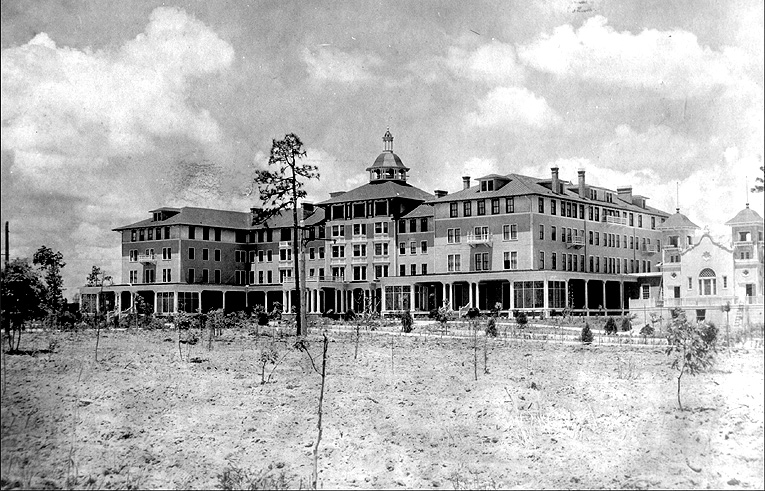
The Carolina – elegance transposed to the middle of the desolate wasteland which was Pinehurst. Courtesy of the Tufts Archives
It didn’t take long for the awe in which they held the neighboring proprietors to turn to plans which would capitalize on their proximity to such luxury. The matter was given a great deal of consideration by the town leaders with the question being, of course, exactly how to help alleviate those travelers from the burden of having to deal with their monetary surplus. As it became clear that it was the ‘old Scotch game’ which was, by far, the main draw for the village seven miles away the path to improved prosperity was evident.
And thus the stage was set for the creation of their own golf club – and their own distinguished chapter within the larger legend.
Following in the footsteps of Pinehurst golf began in Southern Pines with the establishment of Southern Pines Golf Club by the civic leaders.
Well, actually that was not the case. History has always been an elusive item to wrestle with. Even the most conscientious researcher can miss key facts tucked away in the back of some obscure book. And who’s to say the book got it exactly right in the first place? Such are the hazards of attempting to discern the winding paths of antiquity.
As it turns out, Southern Pines wasn’t quite as sleepy as portrayed.
There was a golf course in Southern Pines which opened in January 1896.
Golf began in Southern Pines more than a year before it started in Pinehurst.
It was also a decade before the beginning of the Southern Pines Golf Club.
Unsurprisingly, the storied hotel was primarily the winter home for Northern visitors of means. Here’s a vignette which will give the reader some sense of the place.
Royal welcome to the Governor. Southern Pines crowds the Piney Woods Inn to honor the chief magistrate. Governor Aycock in his happiest frame of mind captured his exotic constituency long before he arose to speak. The ladies vied with each other in the matter of elegant dressing. The brilliant lights, the floral decorations and the handsome toilettes of the women gave an air of luxury and gayety not often seen so far away from large centers of population. It was an enthusiastic assemblage. Aycock said he came to capture the Yankees and found they had captured him. – The Pilot Newspaper
The hotel occupied the high point of the town. This vantage point on the hill – especially from the turrets – offered a panoramic view of the surrounding area. Here is a ground level photo which captures a small section of the 360 degree view.
The wooden structure burned to the ground in 1913. A few years later the owners graciously donated the 7 1/2 acre tract to the town. The only stipulation was that the land be used “in perpetuity” as a park.
“The property is within twelve minutes walk of three quarters of the population. It is a natural bird sanctuary, having dense foliage and spring water, with some twenty varieties of birds. Over the ditch several rustic bridges may be thrown and the banks sown with wild flower seed. At a small expense this might be made a show place as well as a community center for our winter guests”. – The Pilot Newspaper 1929
The donation of the beautiful acreage by the fine members of the Millen family was just the sort of noble gesture which has always given our places of residence their greatest appeal – and provided happy returns beyond counting. Such places of public revitalization – and such admirable philanthropy – are essential to the well being of towns and cities.
Thanks to the efforts of later civic leaders that land is now the province of worn out apartments and crime. Alas, the only matter that carries on “in perpetuity” is that those long gone leaders continue to deal with the chap who wields a pitchfork.
But even before the demise of the first course in the Sandhills, the Southern Pines Golf Club had progressed from an agricultural area to a nine hole affair to a full eighteen holes…and that’s only the first glimmer of yet another intricate area golfing story.
The land which was to become SPGC passed through several hands before becoming a 36 hole golfing area. The region itself was almost entirely settled by Scottish immigrants in the 18th century. Their customs arrived with them and stayed in use for generations. It was only after the Civil War that the use of the Gaelic language faded away. Most of the immigrants were granted fairly large tracts within the Cape Fear basin. These were primarily used for farming and logging/naval stores. A number of those original farms still remain with those families to this day. However, as the years progressed these parcels or parts of them were often sold off to be used for a variety of purposes.
The earliest known records show the land which was to ultimately become the distinctive SPGC golf course was originally owned by a man named Daniel Blue.
Blue’s tract was sold to one of the first Northern settlers who went by the name of George Kemp. He attempted to turn the area into an orchard and a vineyard. The subsequent owner followed Kemp’s horticultural path.
Although the area was no longer known as “Shoe Toe” and Mr. Bilyeu’s “wonderful Lucretia Dewberry” quit the stage many years prior, the dramatic contours of the land remained very much in tact. And it was upon this land they set about forming a course suitable enough to make a good number of visitors delay the westward trolley ride.
-~-
In Richard Mandell’s excellent book “Pinehurst, Home of American Golf” he described the formation of the course as being one “shrouded in mystery”. That is an apt description because the documentation of the earliest days is sparse. However, there are more accounts of these days than has been understood. Before interpreting these accounts let’s look at the facts which can be accounted for.
1906/7 – Course begins as 9 holes – citation
1912 – 2nd 9 added – citation
1914 – Ross consults and does a major rearrangement of the course – citation
1922 – 2nd 18 planned with 3rd 9 in development – citation
1924 – 3rd 9 finished – citation
1928 – SPGC course remodeled – citation
1928 – 4th 9 under construction (by Donald Ross) with plans for a 5th 9 + an 18 hole “miniature course” (plans abandoned due to Depression) – citation
1929 – Two full 18 hole courses open – citation
There is one question which gets asked more than any other: is it a Ross? By looking into the documented facts behind this particular question the overall arc of the early developmental stage of the course can be established to the degree current information makes possible.
An interesting fact about SPGC is that its origination and development were virtually concurrent with Pinehurst No. 2. Later Ross modified both courses to the point where you could say they were total transformed.
Regarding the very first days of both it is simply impossible to say exactly what role – if any – he played. Pinehurst owner Richard Tufts was quoted as saying he wasn’t sure if Ross had anything to do with the first iteration of No. 2. That hardly matters because (like SPGC) it began as a very simplistic 9 hole course. In No. 2’s case it merely went down today’s first fairway and back up today’s 18th. All 9 holes fit into that area.
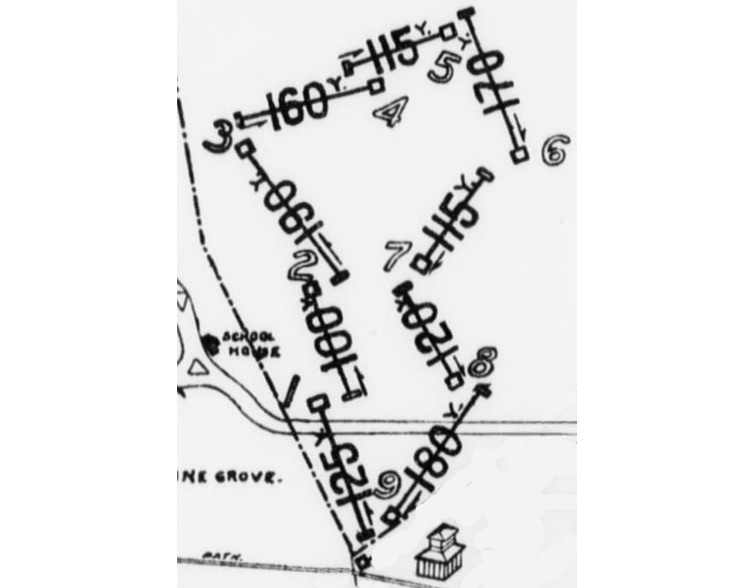
The original version of Pinehurst No. 2. The colossus we know today began in the most primitive manner possible. The very first iteration of SPGC may have been very similar. Courtesy of the Tufts Archives.
Courtesy of Mike Cirba we find information regarding SPGC in the USGA Bulletin of January 1913:
“A nine-hole golf course was laid out by the Board of Directors.”
“The nine-hole addition was laid out and constructed under the direction of the present manager, G. Irving Lenker, assisted in the planning by the president of the club, Dr. W.P. Swett and Mr. Peacock.”
Here is a slightly different account from the local newspaper:
Mr. Peacock is included in both accounts. As you can see in the second account he is joined by James MacNab. And who were these chaps – Peacock and MacNab?
They were Donald Ross’s assistants for many years in Pinehurst.
They started with Ross very early on – years before SPGC began. In addition, they were very close to him personally as well as professionally with MacNab being a Scot and co-owning the Pine Crest Inn with Ross. Peacock was a very good player, club maker and was the head pro at the St. Andrews-by-the-Sea Algonquin course in Canada during the summer.
Here is a photo of Ross with MacNab:
With Peacock and MacNab working for Ross (in Pinehurst) at the exact same time they were involved in building SPGC there is no doubt Ross was familiar with the project. Golf course design turned out (surprisingly) to be in Ross’s blood. Ross and other professionals of the era were trained and expected to wear many hats: greenskeeping, club making, caddy master, etc. However, elaborate design artistry was not in a professionals portfolio at the time. They may have been expected to modify courses or lay out a simple one but the artistry Ross brought to bear in so many places was something latent within him that came to bloom fully.
The point of the previous paragraph is that Ross had an extraordinary degree of natural curiosity and fascination with golf course design. Ross was undoubtedly a perfectionist. This was the period when his profound interest in design was first moving into very high gear. During this period in particular his keenness to master design would have been on a maximum level. When you combine that with his closeness to Peacock and MacNab it is likely – even probable – to say that he would have at a minimum consulted with the individuals building the initial version of SPGC.
Again, there is no known documentation which places Donald Ross as the designer of the first version of either No. 2 or SPGC. That does not necessarily mean that he was not involved to some degree. Whether he was there on site for the beginnings of SPGC or No. 2 is largely academic because as was previously stated Ross ultimately changed them enormously through the course of many years.
The precise configuration of the earliest version of SPGC is unknown. There are a few photographs of what was most likely the first design but the routing remains unclear at this point.
However, there is an extremely detailed account of the comprehensive changes Ross made in 1914 (and possibly 1913). We know this from a May 1914 article in the Charlotte Daily Observer which was kindly provided by Joe Bausch:
“It is understood that quite a number of changes and improvements in the course will be found by golfers who return to SP for the season of 1914-1915. While this course has been growing in popularity from year to year from the date of its inception, it has been the subject of much discussion among the players and stockholders whether it might not be greatly improved by the judicious expenditure of a comparatively small sum of money. the directors at the close of the 1913-1914 season gave this matter most serious attention, and having obtained the advice of the professional-in-charge Mr. William Norton, a recognized authority, and that of Mr. Donald Ross perhaps the most prominent golf professional in the country with the concurrence of the chairman of the greens committee, Mr. T.A. Kelley, himself an excellent golfer with experience of many courses North and South, decided upon the following changes which are already well advanced.
The club house will be remodeled and removed to a site near the seventeenth and eight greens hitherto know [sic], the eighteenth hole of last season will now become the first and will be practically unchanged except that the shoulder will be removed from the putting green. The present second becomes the third and will be improved by moving the putting green a little further back so that it will be without shoulders or banks. The present third becomes the fourth and will be changed by the removal of the tee further down the hill to a distance of 175 yards from the ditch crossing the fair green. The putting green is being moved about 25 yards further back. All who play at SP think ___ about the wood path and the climb from number three green to number four tee and few will regret its elimination. The new tee will be near the fourth green, and the old fourth hole, now the fifth will become an elbow hole, with no alteration.”
The article continues to go on in the same detailed manner for many paragraphs. If you care to try to work your way through the small type here is the original article:
The following may be the first the first photograph of SPGC:
This photograph (and the photo at the top of the page) show the Bilyeu house – which was the original clubhouse. But more importantly the hole which is beside the house bears no resemblance whatsoever to any of the holes which ultimately made up the course. What is the significance of that? It shows the extent of the Ross transformation. The hole you see above (obviously) is free of the advanced styling which was later to be found. It seems likely that the very first version of the course was a primitive affair.
The case of SPGC is quite similar to No. 2. Both started primitively and through Ross’s extended attentions evolved into very advanced courses. One can debate the degree to which he was involved in the very first days but in both cases the assertion that they are Ross courses remains valid.
“The hills are rugged little mountains, giving all the charm desired to a climb or a walk in the pursuit of the game or in a ramble among the pine woods, where walks and roads and springs and forest foliage suggest the primeval.” – SPGC Ad
The topography of SPGC is undoubtedly the most dramatic of the Sandhills courses. The more level areas are set amidst a landscape which continually turns one way or another “heaped in picturesque patterns” around the knolls and ridges. The article which Mr. Cirba provided earlier portrayed a fairly extraordinary degree of consideration being given to sorting out the shot values. It is everybody’s good fortune that was the case because that’s exactly what it took to weave together a coherent and compelling playability within this terrain. On flatter land a lesser talent could more or less put together a string of holes that work passably. But a lesser talent would not have had the wherewithal to discern the unbroken sequence configurations which continues to work so very well here. At the time you could count on one hand the number of designers who had the capability to bring a superior golfing logic to the hills of Southern Pines. And make no mistake, what you’ll find on the SPGC course is the result of a deft hand and very advanced thinking. That is, of course, why it has continued to provide a fascinating golfing journey for more than a hundred years.
God created golf holes. It’s the duty of the architect to find them. – Donald Ross
Most golfers don’t pay a great deal of attention to the major and minor aspects of design. Their golfing experience is not one of advanced thinking – which is perfectly fine. It is not necessary for an elevating experience. The reaction to any given course for most is a visceral one. An ill presented set of holes will elicit one reaction and vice versa. But it is not through the intellect that either response is summoned to the forefront of the individuals experience. It’s the same with many things, actually – like wine, for instance. Is it necessary to know about tannins or what temperature the cellar was kept to enjoy a glass? Or, do you really need to know what was in the roux to enjoy a bowl of gumbo on Bourbon Street? Certainly not. Analysis of such matters is an exercise some enjoy pursuing but courses aren’t made to be analyzed – they are made to be played. Knowledge of what underpins the presentation is not necessary for the golfer or the epicurean.
Whereas most American courses offer a high number of approach shots from flat land the player of SPGC will encounter less redundant fare. In this regard, it reflects more of a British than an American sensibility.
One of the primary charms of the proper British links is that the golfer is presented with scenarios which call for creativity rather than the same shots over and over. The instinctive approach to the situations presented is greatly diminished when precise distances are handed out for yet another shot from a flat pancake fairway. The swings made will be little different from one another. Executing what is essentially the same swing all day long lacks a sense of adventure – and a sense of adventure is what you most definitely will find at SPGC – no matter how many times you play it.
When Tom Watson first started playing the Open he did not enjoy that style of play. That is understandable because the contrast with what most Americans are familiar with is rather stark. Watson thought dart throwing to soggy fairways and greens was the way golf was supposed to be played. Later, he said about the traditional British style: “wait a minute, this is real golf.” Given the opportunity, most Americans – who don’t have an entrenched and inflexible mind set – would also come to greatly appreciate playing shots in a manner which calls for a more artful approach.
The way in which each hole varies from one another is one of the best aspects of SPGC. However, being distinct from one another does not in and of itself make for a recommendable course. Almost anybody could give you a radically different set of holes – but that would be unlikely to provide for an appealing collection. Like the varying aspects of any creative endeavor the elements must relate to one another with a certain sense of balance. This happened to be one of Ross’s strongest suits. SPGC called upon his first tier talents quite a bit more than the less dramatic terrains he often worked with. The fact that he was able to forge not only fascinating individual holes but a masterful collection was an impressive feat. Again, this is an achievement that a fair number may sense but not be entirely conscious of. As with Ross’s best work the closer one examines it the more impressed one becomes with his capabilities.
On many tee shots the player is offered different target areas from which to then approach the green. For instance, the horizontal bulge which crosses the 10th in the area where most drive the ball can leave the player with a somewhat uphill or downhill stance – to a long, 2 1/2 club uphill green. The stance depends on how far the drive was hit. Without that element it’s not such an interesting hole. On the 13th the fairway starts to descend where the average drive is hit. Your approach is usually either from just short of where the ground descends about 150 out (to a downhill green) with a level lie…or a punch wedge from a fairly sharp downhill lie. Which approach would you prefer?
Even on the one shot holes you are presented with some sort of option. For instance, the 7th can play up to about 200 yards. The angled green is set just beyond a cavernous bowl – but there is plenty of bail out room on the right for those who flinch at the perilous carry. There are few places where options are not presented to go along with shots that require great skill to pull off.

The rumpled landscape is much in evidence on the 7th. The angled green is center left – with plenty of bail out on the right.
There are only two aspects which criticism can on occasion be found. Some prefer flatter courses. That’s reminiscent of Watson’s view of the old links courses. In other words, it is largely a matter of unfamiliarity – with a bit of laziness being mixed in there as well. The other matter which has received some criticism is that although terrains and the strategies of the par-3’s vary considerably, the distances of these holes are not so terribly different. The latter critique is usually only to be found among those who spend much more time than the vast majority studying course design. Regarding the former criticism it really is a matter of personal preference – in this case with the majority finding great favor in the varied challenges Ross left us with.
All in all, you will not find a single individual who would say the course is not abundant with personality. That so many have appreciated it for so many decades puts it firmly in a category called “classic” or “gem”.
For a large part of the 20th century SPGC was known as a 27 hole club. Some latter day players were vaguely aware that the land had been cleared for a fourth nine but generally it was thought to have never been realized and put into play. As you saw in the earlier references it was actually a fully functioning 36 hole complex by 1929.
How long did the club remain 36 holes? The following is an article from November 1935 which shows the club to have 27 holes. So, it was but a few short years as a full two course club.
The following 1940 aerial was kindly provided by Craig Disher. The red numbers indicate the holes (which are still current) on what was called the No. 1 Course. The yellow numbers indicate the routing of the 9 hole course which was in play until about a decade ago. The lines with no numbers are the holes which were in play at one time and later to be abandoned.
Going back to the days before the Depression set in the popularity of the two courses was such that 36 holes were deemed to be insufficient – and elaborate plans were made accordingly…
A History of Southern Pines Golf Club
Page 5
The above article shows that in 1928 yet another 9 holes were in the works – a fifth 9. Several other groups were also planning to build courses at this time. Among the places in the area which projected – but never realized the additional courses were: Montevideo, Southern Pines Hotel (two courses), Pinebluff, Lakeview, Vass, Jackson Springs (which was to be a Ross), a night golf course and Pinehurst itself – which had a total of 6 courses planned at this time.
It was high tide for the golfing world in the late Twenties. Although there was already a virtually unprecedented number of courses in the area there was still far more demand than supply. It was this fact that sent developers into high gear. And thus the number of plans on the drawing board was quite something to see.
As we all know these plans came to an abrupt halt with the onset of the catastrophic economic crisis in 1929. SPGC itself came perilously close to closing in the mid Thirties.
The Maples in the above article was Ross’s No. 1 right hand man and was an essential part of the development of the Pinehurst courses. In 1938 he went on to supervise the installation of grass greens at SPGC. Ross himself stayed involved with SPGC until his last decade. In the 1930’s he hand picked the successor (Roy Grinnell) to the long time and much beloved head pro Emmett French.
French was a world class player who at one point finished second to Gene Sarazen in the PGA championship. On another occasion he and Walter Hagen played what was said to be a memorable match at SPGC against (British) Open champion Arthur Havers and French Open champion James Ockenden.
Although many of the best male players found their way to Southern Pines (with Sam Snead setting a course record 63) it was mainly the top women players who squared off on the course. There were all manner of tournaments which were held during the lean years of the Thirties. The most significant was an annual event called the Mid South tournament which ran for a little over a decade.
Turning back to Donald Ross’s long term involvement with the club this 1941 article shows he was not only as an adviser, but also an investor.
Despite heroic efforts of the part of staff and advocates of the club, it ultimately reached an economic breaking point in 1941. Still…it did not close. Nor has it from the first days until now. This is a tribute to many unheralded individuals who over the course of more than a century have been devoted to preserving this fundamental element of civic life.
During the years of severe economic distress the State of North Carolina stepped in with a mandate to…put a highway through the middle of the course. They clearly were oblivious to the genius of the design and its value to the community. They were also oblivious to the wrath of clubs advocates. If the unforgivable loss of the Piney Woods Park showed the town leaders at their worst then the preservation of the course from the depredations of the State showed them at their best.
In the United States there are innumerable stories of irreplaceable examples of the country at its best which have been ruined. Such myopic endeavors quite simply make the country a worse place to live. For instance, Thomas Jefferson’s exquisite refuge “Poplar Forest” was almost paved over for condos with the all too familiar and all too ill conceived urban sprawl. Fortunately for Poplar Forest and for SPGC there were individuals who were adamant that this sort of foul deed not be visited upon these special areas. If not for the efforts of these community leaders the Pinehurst area would have lost one of its essential gems.
Epilogue
After sliding into insolvency the club evolved to a new stage – one it has essentially retained to this day. That is, since somewhere around the mid-century mark it has carried forth largely as a center for the community with the youngest to the oldest members of the families served well. Being located so closely to the center of town has has made this a natural fit. But, to be sure, there has been and continues to be a substantial amount of tourism – especially in the Spring with the florescent shrubbery trailing along the fairways and throughout the town. Those images of nature at its most vivid are, no doubt, the substance of many a traveler’s winter ruminations.
Once played the course usually ends up on the visitors annual or semi-annual area rota. The fact that it has retained the character Ross instilled all those years ago make it most worthy of being selected – even with so many appealing options around. As the course continues to measure under 6,400 yards it is playable to virtually all. Yet even at this length the sharp players find it curiously resistant to scoring. And it is amusing to see the college teams which regularly pass through puzzling over this while wandering back to their vans. The integrity of the Ross design has not been sacrificed for the trendy aberrations the game suffers from time to time. The club continues on in an unassuming manner not at all concerned about comparisons with the more well known companion pieces. Perhaps to stretch it a bit, all the Ross courses in and around the villages can be taken to resemble a family. Some acquire a considerable degree of notoriety and understandably bask in all the flattery. But the Southern Pines course is a bit like the uncle for whom the appeal of such attention has long since exerted much sway – and continues on as deemed proper in a contented and dignified manner.
THE END
Chris Buie is the author of The Early Days of Pinehurst




